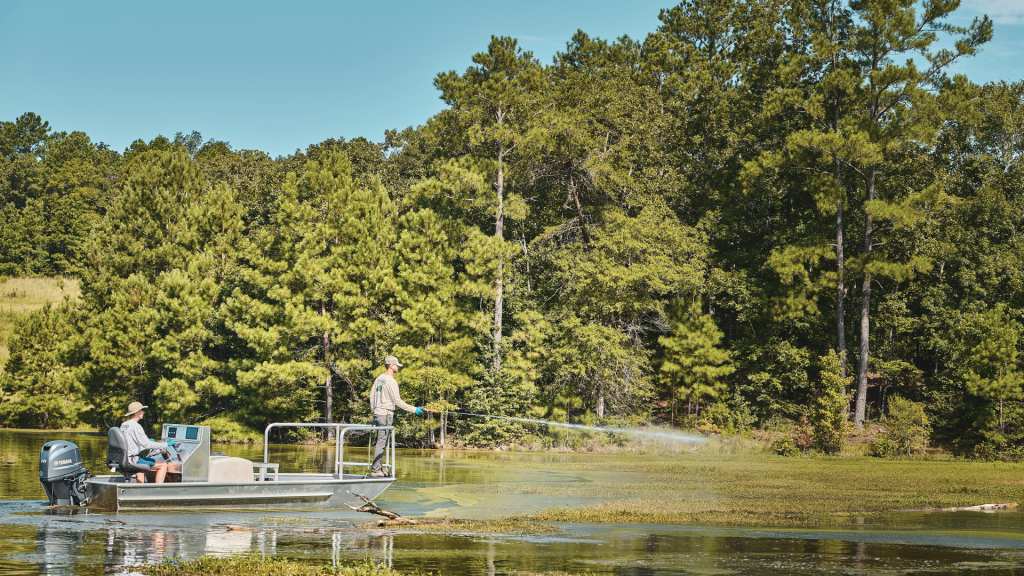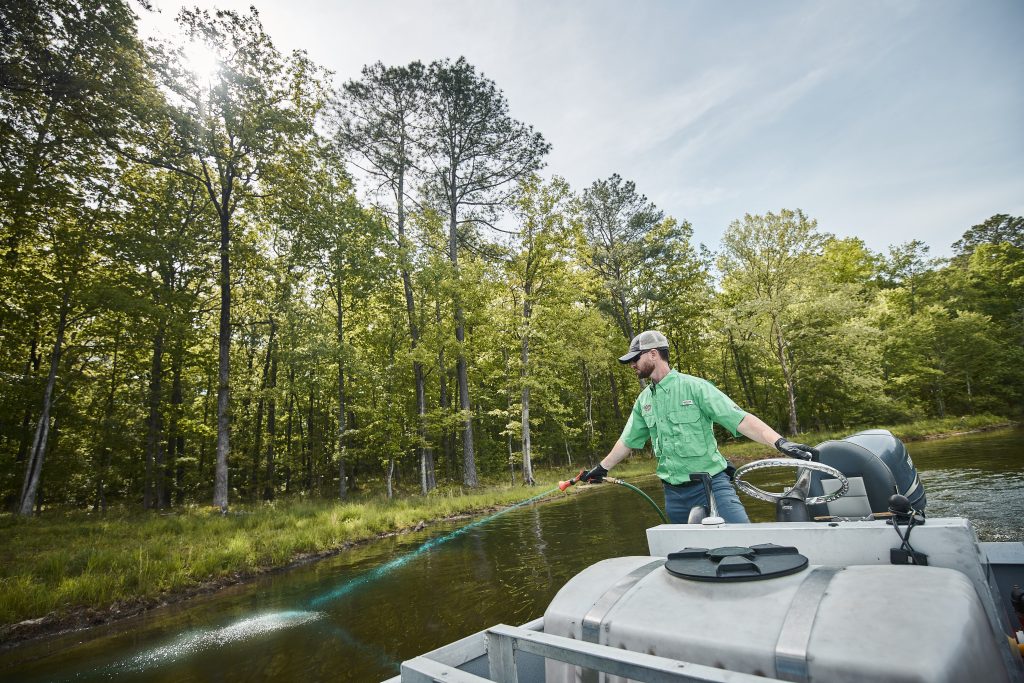Lake and Pond Weed Control Without Herbicides
In addition to food, largemouth bass need cover and structure to provide protection and give them the hiding place from which they can ambush bait fish and grow into big fish. Part of that structure equation is aquatic vegetation. The problem with aquatic vegetation is that sometimes it can just take over and you will need some form of pond weed control.
On an episode of the Alabama Freshwater Fishing Report podcast, Southeastern Pond Management president Norman Latona shared his expertise in how to manage your pond for aquatic weeds and vegetation.
SEPond offers a wide range of services, ranging from ecosystem analysis, management programs, liming, fertilization, fish inventory and removal processes, stocking, weed and vegetation control and more.
Latona pointed out that since the south has a long growing season, sometimes aquatic vegetation can literally take over and it can be challenging to control it. The question is, “how much vegetation is too much”?
“There are a number of strategies that you can put in place to control unwanted and over excessive vegetation and it just isn’t about hammering them with chemicals,” Latona said.
While chemicals have their place in the pond management arsenal, there are other more organic ways to control a pond’s vegetation inventory. Latona pointed out that most aquatic nuisance plants have their origins in the mud in the bottom of the pond and need sunlight to develop and grow. By coloring the water and limiting the amount of sunlight that penetrates down into the water column to the mud, that alone inhibits aquatic weed growth.
According to Latona, it takes three things to grow plants: soil, water and sunlight. While obviously, we can’t control the water or the soil, the one thing we can manipulate and control, to some extent, is the sunshine. He also said that most aquatic vegetation won’t tolerate much shade and is pretty direct intense sunlight dependent and any steps to mitigate the intensity or volume of direct sunlight will inhibit vegetation grown on the pond bottom.

While Latona emphasized that while aquatic herbicides are an effective arrow in his pond management quiver SEPond prefers to take a multi-faceted approach to the weed control problem.
“By liming and fertilizing we are enhancing planktonic algae growth, which is a green plant as well and we can create a shading effect and we can block some of that intense sunlight from ever hitting the bottom which is where most of the nuisance stuff grows, and it is almost like putting a shade cloth across the top of the water,” Latona said. “If weeds do grow it is struggling and it isn’t going to grow in the massive quantities that you see in lakes and ponds that are super clear.”
While on the surface, it sounds nonsensical and rather contradictory, applying sound pond management techniques such as liming and fertilizing to support algae growth, can cut down on unwanted aquatic growth and contribute to a healthy, productive and balanced pond.
“When you talk about liming and fertilizing to control vegetation, it sounds kind of counterintuitive in that you would think that if you fertilize you will grow more weeds,” Latona said. “But what we are attempting to do is grow planktonic algae in the water that give a pond that green tip, reduce sunlight penetration and stop weed growth.”
“Collectively, that actually adds up to a giant shade cloth and cuts down on the visibility and sunlight penetration. Those pond weeds need to have sunlight to grow and if we can keep some of the sunlight off of them, we can usually control the growth because most aquatic weeds need to have some pretty intense direct sunlight to grow,” he said.
Latona said that while it sounds crazy to talk about liming, fertilizing and pond weed control in the cold months it makes sense to start down the path of weed control early and emphasizes that air and water temperature doesn’t really have an effect on weed growth. He emphasized that pond owners need to realize that once this type of vegetation gets established it becomes very difficult to control so the key is to start early.
“Folks get kind of confused and think that if the water temperature is 45 or 50 degrees that weed growth isn’t a factor and that just isn’t the case. It’s just like with trees in that it doesn’t matter what the temperature is, it is all about the number of hours of sunlight needed to stimulate growth” Latona said. “Once that vegetation gets to a certain level of maturity and abundance, you are really fighting a long-term uphill battle to control it.”
The question of how much vegetation is too much vegetation is a tough and tricky one to answer and hinges on what your objectives and goals for your pond are.
For example, from a biological and fisherman’s perspective, there isn’t much of a drawback to vegetation as long as it doesn’t get to the point where it chokes the pond and inhibits the ability of the predators to effectively prey on forage fish and obstruct the ability of fishermen to fish it. If the pond is so full of weeds that it can’t be effectively and enjoyably fished it defeats the whole concept of a fishing pond.
“Bass love vegetation to hide them as predators and so do bluegill and, to some extent, shad who use it to hide from the bass and whatever fish are big enough to eat them. It is also a tremendous source of food because of all the tiny little aquatic insects that we call zooplankton and the tiny snails and crustaceans that it allows to grow and multiply” Latona explained. “Where we run into problems is when it gets to the point when it impedes the ability to fish, especially for bank fishermen. In addition, heavy weed presence may attract snakes, rodents and even semi-aquatic animals like muskrats and beavers to the water’s edge, which some people consider undesirable.”
Authors Note: Otters are very efficient predators when it comes to eating the larger bass or other fish in a pond and that isn’t good news for most fishermen who want to catch big and maybe trophy bass or bluegill.
“For people who maintain nice, manicured and maintained landscapes around the pond with an obstructed view a preponderance of overgrown and tall weeds may not be very aesthetically pleasing, “Latona added.
While Latona emphasized that while aquatic herbicides are an effective arrow in his pond management quiver SEPond prefers to take a multi-faceted approach to the weed control problem. That not only includes liming and fertilizing, chemical treatment and especially in shallow lakes, grass carp.
“Grass carp are not going to completely eradicate aquatic vegetation unless you stock them at a super high density but they are a piece of the puzzle and part of the strategic solution,” Latona said.
Latona said that for the average pond (if there actually is such a thing) stocking grass carp at the rate of 12 to 18 fish per acre is a good rule of thumb.
At the end of the day if liming, fertilizing and the introduction of grass carp just aren’t cutting it, there are always herbicides. In addition, if the pond has the option of drawing down water, the nuisance weeds can be exposed to cold temperatures and that may help do the job.
“We have a handful of approved chemicals that, if they are applied properly, are not harmful to humans, pets or wildlife and don’t hurt the fish,” Latona noted. “We tend to use herbicides more during the heavy growing season, which is the summertime when they are blooming and that is when they can be particularly effective.”
What About Water Drawdown?
“If we have the ability to control the water level, we can draw down the lake or pond and expose the more susceptible areas with the nuisance weeds to the air and sub-zero temperatures and that can be effective,” Latona said.
According to Latona, when you kill weeds they decompose and release all of their nutrients, which helps to stimulate planktonic aquatic algae growth which, in turn reduces the need to fertilize to “cloud” up the water to reduce the amount of sunlight reaching the floor (mud) of the pond. It is like an aquatic compost pile and part of a big interrelated management circle.
“So, we herbicide and in a week or so, the pond will be as green as pea soup because of all the dead vegetation that is basically organic fertilizer and ‘boom’, we stimulate a big plankton bloom without even adding any fertilizer,” Latona said. “We’ve accomplished two things at once.”
Pond Weed Control
A lot of the vegetation issue has to do with water depth. If you have a deep lake and the banks are cut pretty sharply down around a good portion of the lake, chances are you won’t have a lot of super shallow water where vegetation can take a foothold and get established.
Latona points out that if there is “emergent shoreline” and vegetation that grows in the soil around and in the shallow areas and maybe in three or four feet of water in the marginal areas that they will form some mats as they slowly creep outward into the open water. Still, if you do the correct liming and fertilizing the weeds won’t get out further and take over the entire surface area of the pond.
“That is one of those kinds of ‘best of both worlds’ scenarios in my mind,” Latona explained. “You have vegetation along the margins and the baitfish love it, the predators love it and all the fish utilize it for habitat for spawning, protection and ambush of dinner but you don’t run the risk of it growing and taking over open water and becoming a nuisance.”

By coloring the water and limiting the amount of sunlight that penetrates down into the water column to the mud, that alone inhibits aquatic weed growth.
If the water has a green tint to it, it is not only plankton rich, which is the beginning of the pond food chain, but the green tint hinders weed growth because it inhibits sun from reaching the bottom. As we’ve established, weeds grow out of the bottom of the pond. The less sun hitting the bottom the less weeds you will have. Sounds a bit dumb but it is true and that dovetails into water depth as an inhibitor to weed growth. The deeper the water and the greener it is, the less weeds you are going to have because of the tint and most likely the more fish.
If you are constructing a pond, sculpturing the depth is easily done but, if you have an established pond, water depth is a whole different beast.
“If we can get down to sub three feet of water depth, we can eliminate a lot of the shallow areas that attract vegetation that leads to an owner having to spend a lot of time and money on pond weed control for years to come,” Latona said.
